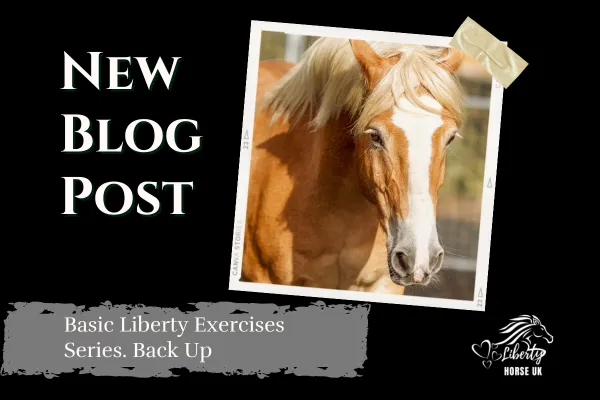Blog

Basic Liberty Exercises Series. Back Up
Introduction:
In this article we will discuss the many benefits to teaching your horse to back up and why I teach the exercises in this order.
Firstly, by teaching the back up, you are checking another safety feature. Does your horse know how to stop and move away from you on cue. You need to be certain that this piece is installed before you ask for the draw towards you. Secondly, asking for the back up is this first step towards collection and the horse understanding how to take more weight on the hindleg. It is important to teach this before teaching the forehand yield as it is very difficult for the horse to move his forehand when all his weight is on it!
1. How to teach the back up
I like to find something that the horse understands to help him with this. Most horses will respond to gentle backwards pressure on the leadrope, directed towards the middle of their chest. It’s important this pressure is central or otherwise you will lose straightness. If he does not understand this simple cue, you may need to back up your cue with a gentle waving motion of your stick. As soon as he starts to think backwards, release, reward and relax to reinforce the desired behaviour.
Once the horse starts to understand the backwards pressure on the rope, I start to transfer this onto a visual cue or voice cue. Use the new cue, old cue principle to transfer the cues.
New cue eg. stick motion -> micro pause -> old cue (backwards rope pressure)
Eventually, he will start to anticipate the back up as soon as he sees the new cue and you can fade out the old cue.
2. How NOT to teach the back up!
The least effective way to teach the back up is with direct pressure on the horse’s chest. This will encourage him to lean into you and push back. It is useful to install this cue eventually. If you’ve ever tried to get a horse off your foot, you’ll know why.. But it wouldn’t be my starting point, particularly with a horse who has learnt to push into the handler.
3. Back up in the leading position
As your training progresses, you will also want to teach the back up in the leading position. Your cue for this can be anything that works for you, but bear in mind the eventual goal of working without a rope and at a distance. For that reason, you want to work towards a visual or verbal cue.
Practice on the leadrope first, using the new cue, old cue principle above. Use the leadrope to help explain what you’re after and through consistent repetition, your horse will eventually understand and you can fade out the rope.
4. Don't try to get everything perfect at once!
Accept that when you are learning something new, you are not going to get the straightness, distance and energy all in one go! Decide what you will focus on first. For example, develop the energy in the steps first and don’t worry about the straightness. When it is time to concentrate on straightness, don’t expect as many steps or as much energy. Use your environment to help you, such as a fence or poles on the ground and build up the amount you ask for over time..
Other resources to help you get started
Liberty Horse UK runs monthly online shows, progress awards and trick titles. Members have access to a video library which runs you through the progressive training programme. For more information CLICK HERE
If you would like to have a go at the level one exercises, why not download our FREE WORKBOOK to guide you.


Contact Us
info@libertyhorseuk.com
07977 909283
© Copyright 2023 Liberty Horse UK. Privacy Policy